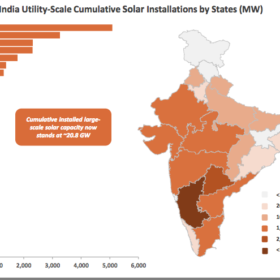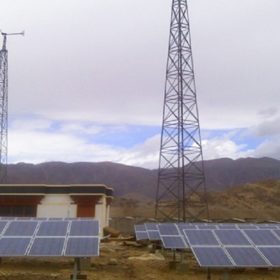SECI extends 3 GW manufacturing-linked solar auction by two weeks
After a pre-bid meeting with solar power developers on September 6, India’s Solar Energy Corporation of India (SECI) is looking to amend the tender document, which it hopes to upload to its website in the coming days, following approval from the ministry, according to a SECI spokesperson.
India: Karnataka tops in renewables capacity, may double it in a decade
Owing to a rapid scaling up of solar capacity, Karnataka has overtaken Tamil Nadu to become India’s top state in terms of installed renewable energy capacity. The state installed 5 GW of new PV capacity in 2017-18 alone—according to a report by the US-based Institute for Energy Economics and Financial Analysis (IEEFA).
India invites 2.5 GW bids for ISTS-connected wind-solar hybrid projects
The projects are to be developed on a build-own-operate basis for an aggregate capacity of 2,500 MW. The eligible bid capacity is 200-500 MW, with a project capacity of at least 50 MW at one project site. The maximum tariff payable to each project developer is fixed at Rs 2.93/kWh for the entire term of 25 years.
The economic case for corporate solar PPAs in India now compelling
India saw 1.8 GW of corporate solar power purchase agreements in place by the end of 2017. There was a rush of installations for PV projects due to open access waivers. The market is expected to contract slightly this year as waivers are rolled back, but there will be sustained market growth through 2023.
Is national 225GW renewables target achievable?
There was incredulity in some quarters as the federal government raised its renewables ambition another 22%, but the stellar performance of the past four years points to the new target being a realizable one.
India: The first solar plant bid at INR 2.44 expected to go live in August
The Indian Ministry of New and Renewable Energy (MNRE) says the nation will exceed 175 GW of installed renewable energy capacity as plans for bidding for 115 GW of renewable power projects to March 2020 were announced. The target for PV parks has been increased from 20 GW to 40 GW with some 41 parks in 21 states – with aggregate capacity of more than 26 GW – already sanctioned.
India announces new policy for wind-solar hybrid systems
India has unveiled a national wind-solar hybrid policy that provides a framework for promotion of large grid connected wind-solar PV systems for optimal and efficient utilization of transmission infrastructure and land, reducing the variability in renewable power generation and thus achieving better grid stability.
India is key to world’s sustainable growth – GGGI Interview Part I
Dr. Frank Rijsberman, Director-General, Global Green Growth Institute (GGGI), South Korea, speaks to pv magazine about its ventures in the Indian solar and storage market. Rijsberman outlines that the country’s growing and diversifying economy, with its ambitious renewable targets, can help to capitalize on the demographic dividend. As a result, it can become the world’s primary consumer sustainable growth market.
Energy Access Summit 2018 highlights
The India Energy access summit held in India on February 12-13, 2018 in New Delhi, saw discussions on the decentralized renewable energy sector from various organizations and institutions, including few announcements.
Interview: Combining umbrella with solar
In an interview with pv magazine, Thinkphi founder Samit Choksi discusses the company’s expansion into sustainable product development and how solar energy is being harvested through it.















